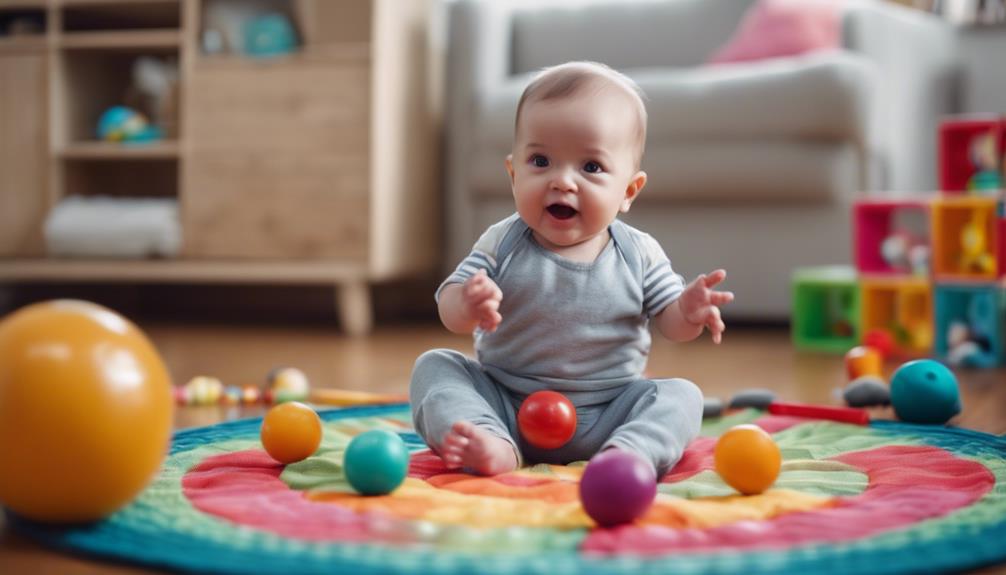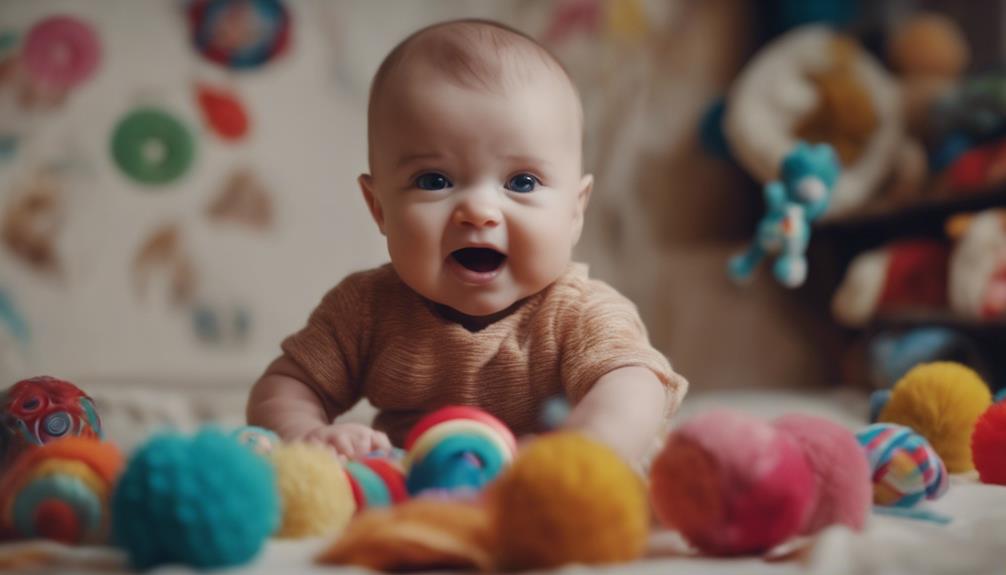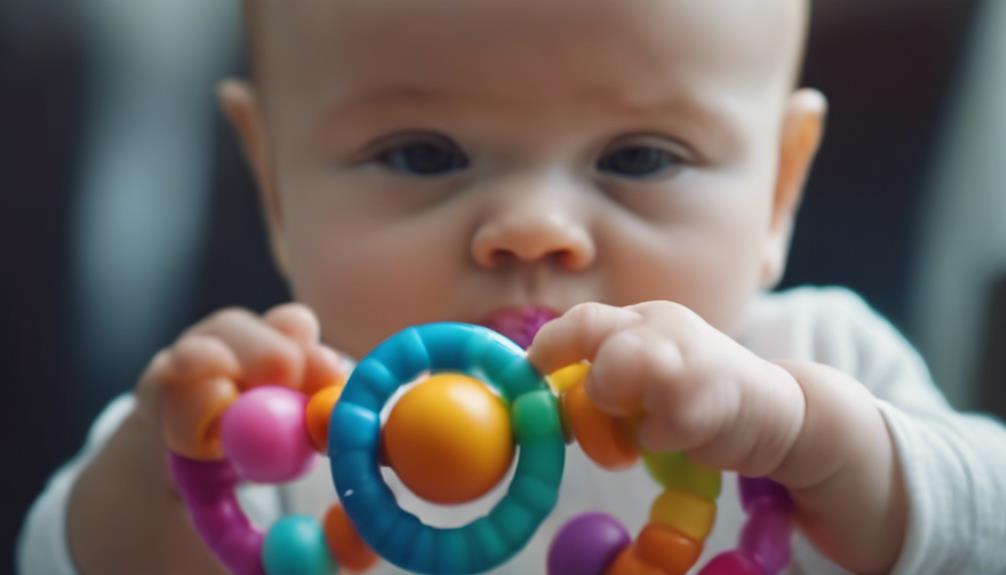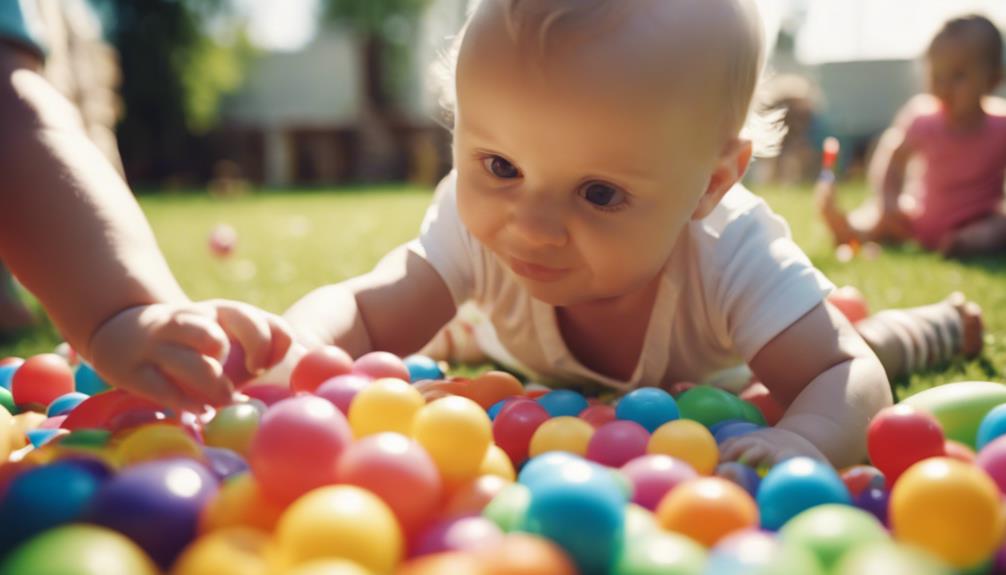Engage your infant with a rattle for comprehensive developmental advantages. This interactive toy stimulates sensory exploration, enhances hand-eye coordination, and fosters cognitive growth. By engaging with a rattle, your baby builds muscle strength, refines fine motor skills, and even enhances problem-solving abilities. The tactile and auditory stimulation offered by rattles enrich sensory experiences, improving overall cognitive development. Furthermore, playing with a rattle can strengthen the bond between you and your baby, encouraging social development and emotional well-being. The advantages of incorporating a rattle go beyond mere play, creating a foundation for holistic growth and learning opportunities.
Key Takeaways
- Enhances sensory exploration and hand-eye coordination.
- Stimulates cognitive development and problem-solving skills.
- Improves fine motor skills, dexterity, and muscle strength.
- Fosters social bonding and emotional well-being.
- Encourages physical activity, muscle control, and spatial awareness.
Importance of Baby Rattles
Baby rattles play a crucial role in enhancing early development by stimulating sensory exploration and promoting essential skills in infants. These rattles aren't just toys; they're tools that aid in the development of motor skills, sensory development, hand-eye coordination, cause-and-effect understanding, social bonding, problem-solving abilities, fine motor skills, and gross motor skills.
When babies interact with rattles, they engage in activities that help them grasp objects, improving their fine motor skills. The sounds and textures of the rattles contribute to sensory development, while the act of reaching for and shaking the rattle enhances hand-eye coordination. Moreover, babies learn about cause and effect as they understand that shaking the rattle produces sound.
Social bonding between parents and infants is also strengthened through shared play with these toys, providing comfort and soothing during distress. Overall, baby rattles are multifaceted instruments that support various aspects of a child's growth and development.
Cognitive Development Stimulation

When babies engage with rattles, they aren't just playing – they're actively stimulating their cognitive development.
These interactions help enhance memory and attention as infants learn to recognize patterns and anticipate outcomes.
Through problem-solving skills, spatial awareness, and exploration with different types of rattles, babies are laying the foundation for essential cognitive skills.
Memory and Attention
Engaging with rattles during playtime can greatly enhance your baby's memory and attention skills, fostering cognitive development stimulation. When your little one shakes a rattle and hears the sound it produces, they are not just having fun; they are also improving their memory retention and cognitive development. The repetitive nature of this activity helps in reinforcing neural connections, aiding in memory formation. As your baby learns to anticipate the sound of the rattle, their ability to focus and engage with the task at hand is enhanced. This practice of selective attention and concentration skills is essential for their overall cognitive development.
| Benefits of Rattle Play for Memory and Attention |
|---|
| Memory Retention |
| Cognitive Development |
| Anticipate Sound |
| Focus |
| Engage |
Problem-Solving Skills
By exploring cause-and-effect relationships through play with rattles, infants can enhance their problem-solving skills and stimulate cognitive development. As babies shake the rattle and observe the corresponding sound, they begin to understand the connection between their actions and outcomes, laying the foundation for problem-solving abilities. This process fosters cognitive skills like critical thinking and logical reasoning, essential for handling challenges as they grow.
Additionally, interactions with rattles aid in the development of object permanence, where infants grasp that the rattle still exists even when out of sight. This understanding contributes to their problem-solving capabilities by allowing them to anticipate the rattle's presence and plan their actions accordingly.
Through engaging with rattles, infants not only enhance their problem-solving skills but also nurture spatial awareness, memory retention, and attention span, promoting holistic cognitive development during this critical stage of growth. Encouraging such play can have long-lasting benefits on the cognitive abilities of infants.
Spatial Awareness
Developing spatial awareness in infants is essential for their cognitive development and is greatly facilitated through play with rattles. The act of tracking the rattle's movements and reaching out to grasp it not only enhances their motor skills but also helps in understanding spatial relationships.
The combination of movement and sound in rattles engages babies' spatial cognition, allowing them to locate and interact with the toy in their environment. Through shaking, grasping, and following the rattle's motions, infants gradually develop depth perception and a sense of spatial orientation.
This early exposure to spatial awareness lays an important foundation for future cognitive abilities and problem-solving skills. By actively exploring the spatial dimensions of their surroundings through rattle play, babies are intuitively honing their understanding of object relationships in space, which is fundamental for their overall cognitive growth.
Hand-eye Coordination Enhancement

Playing with rattles can greatly enhance your baby's hand-eye coordination. Through grasping the rattle, tracking its movements visually, and practicing coordination skills, your little one is developing essential motor skills.
This tactile experience not only strengthens the connection between their eyes and hands but also sets the groundwork for future coordination abilities.
Improved Grasping Skills
Enhance your baby's hand-eye coordination and grasping skills through play with a rattle. By manipulating the toy, your little one practices holding and shaking, which in turn aids in the development of fine motor skills and dexterity. The act of grasping a rattle helps strengthen the muscles in their hands and fingers, promoting better control over their movements.
As your baby reaches for the rattle and shakes it, they're honing their ability to coordinate their hand movements with visual input. This repetitive motion of shaking the rattle encourages the development of hand-eye coordination, an essential skill for various activities in life.
Additionally, holding onto the rattle and exploring its textures further refines their fine motor skills.
Through these simple yet engaging interactions with a rattle, your baby is laying the groundwork for improved hand-eye coordination and enhanced grasping abilities, setting the stage for future developmental milestones.
Visual Tracking Development
Improving your baby's hand-eye coordination can be achieved through engaging with visually stimulating rattles. Visual tracking development is an essential aspect of your infant's early growth, as it aids in their ability to focus, follow, and predict the path of moving objects like the rattle.
The colorful designs of rattles serve to capture your baby's attention, enhancing their visual tracking skills. As your baby tracks the movements of the rattle with their eyes, they're simultaneously refining their hand-eye coordination.
By reaching out to grab and shake the rattle, your little one is honing their motor skills and coordination abilities. This interaction between their visual perception and hand movements not only enhances hand-eye coordination but also promotes overall coordination skills.
Encouraging your baby to engage with rattles can be a fun and effective way to support their visual tracking development and enhance their motor and coordination skills.
Coordination Practice Opportunity
Engaging with rattles offers infants a valuable opportunity to refine their hand-eye coordination skills through interactive play. The act of reaching for, grasping, and shaking the rattle not only enhances their motor skills but also provides a platform to practice coordination.
As babies focus on the rattle, their visual tracking skills are honed, aligning what they see with their hand movements. This repetitive action of shaking and manipulating the rattle serves as a practice ground for coordinating their hand-eye movements effectively.
By engaging in these activities, infants fine-tune their hand-eye coordination, laying a foundation for more complex movements in the future. The interactive nature of playing with rattles encourages babies to concentrate on the task at hand, fostering the development and improvement of their coordination skills.
Hence, the simple act of playing with a rattle can significantly contribute to the enhancement of an infant's hand-eye coordination abilities.
Gross Motor Skills Promotion

Playing with rattles actively promotes the development of gross motor skills in babies by engaging their large muscle groups in shaking and reaching activities. This interaction aids in enhancing control, coordination, and physical growth.
Here is how playing with rattles supports the promotion of gross motor skills:
- Strengthening Muscles: The repetitive motions involved in shaking and reaching with rattles help strengthen the large muscle groups in babies, preparing them for more complex physical activities.
- Improving Control and Coordination: By engaging in these movements, infants learn to control their muscle actions and coordinate different body parts, laying a strong foundation for future physical milestones.
- Encouraging Physical Activity: Rattles encourage babies to move and explore, promoting physical activity that's essential for the development of gross motor skills.
Tactile and Auditory Stimulation

Rattles provide babies with both tactile and auditory stimulation, contributing to their sensory development in multiple ways. Through tactile stimulation, babies explore different textures and shapes, enhancing their sense of touch. As they grasp, shake, and manipulate the rattle, fine motor skills are developed.
The auditory stimulation from the rattle helps babies distinguish between tones and sounds, enriching their sensory experience. This engagement also plays an essential role in promoting cognitive development by capturing their attention and facilitating sensory learning.
The combination of tactile and auditory stimulation offered by rattles fosters a well-rounded sensory experience for babies. By encouraging them to engage in activities that involve both touch and sound, rattles support the holistic development of sensory skills. This dual sensory input not only aids in fine motor skill enhancement but also plays a critical role in shaping babies' cognitive abilities, ultimately contributing to their overall sensory development.
Sensory Experience Enhancement

Enhancing babies' sensory experiences, rattles provide a multi-dimensional stimulation that supports various aspects of their development. When babies interact with colorful and moving rattles, they engage in a sensory-rich environment that fosters growth in different areas:
- Auditory Discrimination Skills: The sound produced by rattles helps infants differentiate tones, thereby enhancing their auditory discrimination skills.
- Fine Motor Skills Development: Tactile exploration with rattles allows babies to practice grasping, shaking, and manipulating objects, contributing to the development of fine motor skills.
- Visual Tracking Skills: As babies track the colorful and moving rattles with their eyes, their visual tracking skills are improved, enhancing their ability to follow objects and movements.
Through these sensory experiences, babies not only develop their sensory perception but also lay the groundwork for language development, cognitive growth, and social-emotional skills.
The multi-sensory nature of rattles provides a holistic approach to stimulating various aspects of a baby's development.
Fine Motor Skills Development

To develop fine motor skills, babies use rattles to strengthen their hands and fingers through grasping and manipulation. The act of holding and shaking rattles not only enhances their hand-eye coordination but also helps in refining their grasp and control over their fingers.
The lightweight nature of rattles makes them ideal for babies to explore and manipulate, aiding in the development of fine motor skills. Interacting with rattles provides babies with valuable lessons in cause and effect relationships, as they learn that shaking the rattle produces a sound.
This process of understanding consequences and engaging in problem-solving activities contributes to cognitive development. By shaking rattles and observing the resulting noise, babies are actively participating in activities that stimulate their fine motor skills and cognitive abilities, laying an important foundation for their overall development.
Social and Emotional Benefits

Engaging in interactive play with rattles can strengthen the emotional bond between you and your infant, fostering moments of connection and joy. This form of interactive play goes beyond mere entertainment; it plays an essential role in your infant's social development and emotional well-being.
Here are some key benefits of engaging in rattle play with your baby:
- Parent-Child Bond: Interactive play with rattles strengthens the parent-child bond, creating shared moments of connection and love that are vital for healthy emotional development.
- Self-Soothing: Rattles serve as self-soothing tools for infants, helping them relax and calm down during moments of distress. The calming effect of rattles can have a positive impact on your baby's emotional well-being during playtime.
- Social Development: Through shared moments of joy and interaction with rattles, infants experience bonding experiences that promote social development, laying the foundation for healthy relationships in the future.
Frequently Asked Questions
How Does a Baby Rattle Help With Physical Development?
Using a baby rattle helps your little one with physical development by engaging large muscle groups, improving coordination, and strengthening muscles over time. It's a fun and beneficial way for babies to enhance their motor skills.
How Do Rattles Benefit Sensorimotor?
Rattles benefit sensorimotor skills by engaging auditory, tactile, and visual senses. The sound helps you discern tones, tactile exploration refines fine motor skills, and visual tracking improves as you follow and interact with the rattle.
How Do Infant Rattles Benefit the Baby in Perception?
When babies interact with rattles, they enhance their auditory, tactile, and visual perception skills. Different sounds, textures, and colors help babies differentiate and explore their senses, contributing to overall sensory development in infants.
Is Holding a Rattle a Fine Motor Skill?
Oh, holding a rattle? Of course, it's a fine motor skill! You're building those tiny hand muscles, honing control, and setting the stage for future tasks like writing and drawing. Keep shaking and growing!
Conclusion
To sum up, baby rattles aren't just toys, but essential tools for fostering a range of developmental benefits in infants.
From cognitive stimulation to fine motor skills development, these simple objects play a vital role in a child's growth and learning.
So next time you see a baby happily shaking a rattle, remember that they aren't just playing, but actively engaging in important developmental activities that will shape their future.









